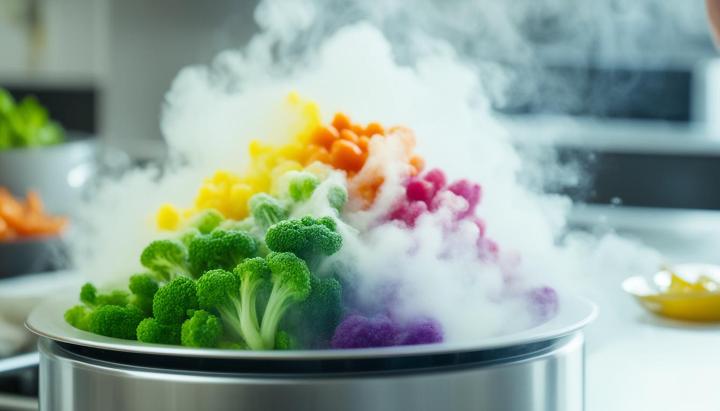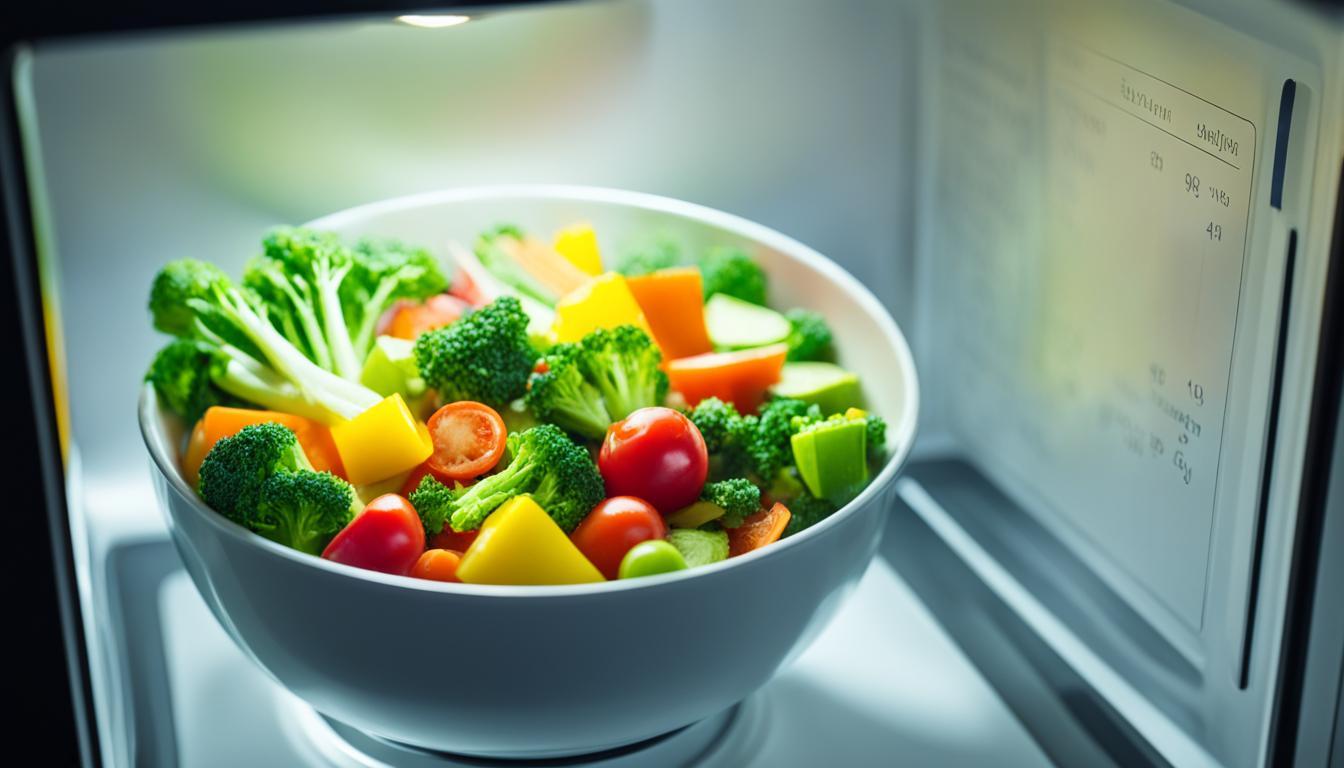Microwave Cooking: Does It Kill Nutrients?

It's a question that has echoed through kitchens for decades – does microwaving kill nutrition? Amidst busy schedules and the quest for quick meal prep, our trusty microwaves offer a saving grace. But could these handy devices be zapping away more than just the clock time? Studies have probed deep into the nutritional value in microwave cooking, seeking truth beyond the common skepticism. We've sifted through the scientific jargon and are here to share revelations on the microwave cooking effects – because what's on your plate deserves to be both convenient and wholesome.
Key Takeaways
- Microwave cooking has been scrutinized by scientists for its effects on the sources of nutrientsfound in food.
- Structural changes in starches and proteins have been noted, but the nutritional impact appears minimal.
- Moisture loss is higher in microwave cooking, but proteins, lipids, and minerals remain largely unaffected.
- When comparing vitamins retention, microwaving holds its own against conventional cooking methods.
- The real concern isn't the cooking method, but rather how we use it – from power levels to container choices.
- Preserving nutrients can be managed with proper microwave usage and best practices.
Introduction to Microwave Cooking and Nutrient Retention
As we dive into the details of microwave food safety and nutrient retention, it's important to understand how this ubiquitous kitchen appliance has revolutionized meal preparation. Microwave ovens operate by converting electricity into electromagnetic waves, more commonly known as microwaves. These microwaves agitate molecules within food, notably water, but they are also capable of heating fats and sugars, which generates internal friction and cooks the food evenly and quickly from the inside out.
The health impact of microwaving food has been a topic of considerable discussion, and we're here to clarify what happens to your meals inside this modern cooking device. Microwaves emit what's called non-ionizing radiation—a kind of radiation that's similar to cell phone signals but more intense—which is why microwave ovens are equipped with specialized safety features to prevent any leakage. When properly used, these ovens are not only safe but can also contribute to preserving nutrients in microwave cooking.
Remember, to safeguard the nutritional integrity of your food items and your health, it's crucial to use only containers labeled as microwave-safe. This practice plays a pivotal role in microwave food safety.
Indeed, one of the perks of microwaving is the potential to retainmore essential vitaminsand minerals. Unlike conventional cooking techniques that may require longer exposure to heat and water, microwaves can minimize the nutrient depletion often seen in boiled or overcooked foods. Our goal is to equip you with knowledge on effective microwave cooking practices that prioritize both the nutritional benefits and the culinary quality of your favorite dishes.
Next up, we'll delve into common misconceptions and the real effects of microwave cooking on your food's nutritional content. Our continued discussion will explore these aspects further, ensuring you're well-informed on all facets of microwave use for healthy living.
Debunking Microwave Nutrition Myths
As we explore the kitchen landscape, it's essential to clear the air on some of the most persistent myths about microwaving food. This age-old debate—microwave versus traditional cooking methods—often leaves many unsure about the safety and nutritional value of microwaved food. So, let's delve deeper and separate fact from fiction.
Understanding Microwaves and How They Work
Microwave ovens have become a staple in households for their efficiency and convenience. Yet, the science behind microwaving is often misunderstood. Contrary to some fears, microwave radiation effects on food do not involve harmful ionizing radiation but rather electromagnetic waves that excite water molecules, gently heating the food. With robust safety measures, like metal shields, these appliances are designed for microwave food safety, safeguarding against radiation leakage.
Microwaving vs. Traditional Cooking: Nutrient Impact
The age-old question of microwave versus traditional cooking methods often centers on the impact of microwaving on vitamins and minerals. While cooking methods such as boiling or frying can result in nutrient losses, the swift nature of microwave cooking generally helps retain more of the food's original nutritional value. This is particularly important when considering heat-sensitive nutrients that are vital to our health.
Common Misconceptions About Microwave Safety
Many misconceptions circulate about the safety of microwaving food, from fears of nutrient destructionto concerns over radiation. However, these are largely debunked microwave nutrition myths. When used according to the manufacturer's instructions, and with regular maintenance, microwave ovens are a safe method of food preparation without compromising on nutritional value or impact of microwaving on nutrients.
Let's compare the nutritional impact of microwaving versus boiling in terms of vitamin C retention in broccoli:
Cooking Method | Nutritional Value (mg of Vitamin C per 100g) |
Boiling | 64 mg |
Microwaving | 78 mg |
The table clearly illustrates how microwaving preserves the nutritional value of microwaved food more effectively, debunking the myth that microwaving drastically reduces the vitamin content of foods.
By understanding the mechanics, comparing cooking methods, and addressing safety concerns, we are well on our way to making informed decisions about our cooking choices. Remember, the power to optimize the nutritional value of microwaved food lies in understanding the facts, including aspects such as the timing of pre-workout meals and snacks, leading to healthier meals and peace of mind.
Does Microwave Kill Nutrition: Evaluating Scientific Evidence
As we delve into the scientific discussions surrounding microwave cooking, one question often emerges: What is the impact of microwave radiation on food nutrients? The answer lies within a wealth of empirical data that reinforces the fact that microwaving generally preserves the nutritional value of food.
Research looking at nutrients in microwaved food indicates that key constituents such as starches, proteins, lipids, and minerals maintain their nutritional integrity. Crucially, the microwave cooking impact on nutrients triggers concern among health-conscious individuals, but our analysis points to reassuring conclusions. Microwaves perform comparably to traditional cooking methods, with certain nutrients in microwaved food even showing better retention rates due to reduced cooking times and lower temperatures.
Let's explore a comparative breakdown of how microwaving food stands against conventional cooking in terms of preserving essential nutrients:
Nutrient | Retention in Microwave Cooking | Retention in Conventional Cooking |
Vitamin C | High, due to less exposure to heat and the absence of water | Lower, because vitamin C can leach into cooking water |
B-Vitamins | High, with short cooking times reducing nutrient loss | Varies, with factors like water usage and heat affecting retention |
Minerals (Calcium, Potassium, etc.) | Very High, minerals are not significantly heat-sensitive | High, though prolonged cooking can cause some mineral depletion |
It becomes clear that the microwave radiation effect on food nutrients might not be as detrimental as previously thought. This suggests that microwave cooking might indeed be a safe and efficient way to preserve the nutritional profile of our meals.
Preserving Nutrients in Microwave Cooking
When we think about microwave cooking, our minds often jump to convenience and speed. Yet, one of the key benefits of using a microwave, which might not be immediately apparent, is its ability to maintain the nutritional value of our food. To achieve this, we must embrace certain best practices for cooking in a microwave.
Optimizing Microwave Cooking Time and Power Levels
Understanding the relationship between microwave cooking and vitamins retention is akin to mastering a delicate dance. The right combination of time and power level is critical for preserving nutrients when using a microwave. Shorter cooking times at appropriate power settings help prevent the breakdown of heat-sensitive vitamins and antioxidants, ensuring the retention of essential fat-soluble antioxidantscrucial for maintaining health. In essence, the rule of thumb we follow is: 'less is often more' when it comes to power levels and cooking durations in microwave cooking.
Choosing the Right Containers for Healthy Microwave Cooking
Ensuring microwave safety for nutrients doesn't stop with timing and power levels; it also extends to the containers we use. Containers not marked as microwave-safe can release undesirable chemicals into our food. They may also not heat food as evenly, potentially leading to nutrient loss. Therefore, we always opt for glass or microwave-specific plastics to safeguard the nutritional value in microwaved food.
Techniques to Minimize Nutrient Loss
Despite misconceptions, nutrient loss in microwave cooking can be minimized with strategic approaches. Employing techniques like using minimal water for steaming can serve to preserve the water-soluble vitamins in vegetables. We often find that covering foods to trap steam, and flipping or stirring midway through cooking, results in not only evenly cooked meals but also greater nutrient retention. Adjusting our microwave habits ensures that we are not just cooking efficiently but also healthfully.

Comparative Studies: Microwave Versus Traditional Cooking Methods
When exploring the debate of microwave vs conventional cooking nutrients, it's essential to look at the evidence presented by comparative studies. These investigations shine a light on the effectiveness of microwaving and nutrient retention, often challenging commonly held beliefs about cooking methods and their impact on our food's nutritional value.
One key element we've discovered is that when it comes to microwave versus nutrient retention, the microwave oven can be a powerful ally. This is particularly true for cooking vegetables, where it retains antioxidants more effectively than boiling. The secret lies in the speed and gentleness of the cooking process — microwaves cook quickly without the need for high temperatures that can break down vitamins and other essential nutrients.
We've compiled a table comparing nutrient retention in vegetables using different cooking methods. The data reflects how microwave cooking stacks up against boiling and steaming, giving an informative glimpse into the benefits of each technique.
Vitamin/Mineral | Microwave Cooking Retention | Boiling Retention | Steaming Retention |
Vitamin C | High | Low | Medium |
Antioxidants | Very High | Low | High |
B Vitamins | Medium | Low | Medium |
Minerals (Iron, Potassium, etc.) | High | Medium | High |
Flavonoids | High | Low | High |
Phytochemicals | High | Low-Medium | Medium-High |
As reflected in our table, microwaving shows a consistent pattern of preserving nutrients at levels that are often higher or comparable to those resulting from steaming, and significantly better than boiling. It's critical to note that retention levels can be influenced by factors such as the specific vegetable, cooking duration, and power setting of the microwave.
Ultimately, our research indicates that employing a microwave can be a strategy worth considering for those who are conscious about microwaving and nutrient retention. By choosing the right microwave settings and cooking times, we are more likely to enjoy not only convenient and quick meal preparation but also a nutritiously rich one.
Healthy Microwave Cooking Tips
Exploring the numerous benefits of microwave cooking, we've gathered impactful strategies to ensure that every meal is not just convenient, but also nutritious. By implementing certain cooking methods and understanding the science behind microwave vs oven nutrition, we assure that our food maintains its highest nutritional value. Let's dive into some of these smart and healthy microwave cooking tips together.
Tips for Even Cooking to Preserve Nutrients
To evenly cook in microwave and preserve the nutritional value of your food, take a moment to arrange your meal thoughtfully in the cooking vessel. Stir halfway through the cooking time and rotate the dish if necessary. This will prevent cold spots and ensure each bite is infused with warmth and sustenance.
Steaming Vegetables in the Microwave to Retain Vitamins
When it comes to steaming vegetables in the microwave to preserve vitamins, we believe in the gentle touch. A splash of water and a microwave-safe lid can create a steamy haven for your veggies, locking in those precious water-soluble nutrients. Steaming is particularly kind to delicate nutrients, showcasing one of the many benefits of microwave cooking.
Best Practices for Reheating Foods
When reheating, our goal is more than just warming up leftovers. The best practices for reheating in microwave include using microwave-safe containers and covering food with a damp paper towel to keep the moisture in. Be wary of overheating, as it can not only spoil the texture but also the nutritional profile of the food.
Cooking Practice | Benefits | Tips |
Stirring Periodically | Prevents nutrient degradation | Stir food at least once mid-cooking |
Even Arrangement | Ensures uniform heat distribution | Spread food in a circular pattern |
Steaming | Preserves water-soluble vitamins | Use a small amount of water and a microwave-safe lid |
Impact of Microwaving on Vitamins and Minerals
As we delve into the nuances of microwave cooking, it's crucial to understand the real impact of microwaving on vitamins and minerals, aspects often surrounded by questions and misconceptions. Let's explore how microwaving might lead to nutrition loss in a microwave and how we can utilize this technology while maximizing vitamins retention in microwaving.
Microwaving and Vitamin C: Does the Heat Destroy It?
Contrary to common fears about the effects of microwaving on fat-soluble vitamins and water-soluble ones like Vitamin C, the heat from microwaving does not necessarily destroy them. In fact, when considering microwave cooking nutrients, the quicker cooking times and the reduced need for water can help preserve Vitamin C, reducing the chances of it leaching out unlike in boiling processes.
Effects of Microwaving on Fat-Soluble Vitamins
If you're curious about the preserving nutrients when microwaving, particularly fat-soluble vitamins, you'd be pleased to know that these nutrients—Vitamins A, D, E, and K—are quite tenacious. Microwaving foods rich in these vitamins generally maintains their integrity, ensuring that we get the benefits of microwaving without losing nutrients.
Mineral Retention in Microwaved Foods
Let's talk about mineral retention in microwaved food. As elements that withstand heat well, minerals like calcium, magnesium, and potassium, remain largely unaffected during microwaving. This means that the microwaved food health impacts are minimal when it comes to mineral content, reassuring us that we can enjoy convenience without compromising on mineral intake.
Conclusion
In wrapping up our examination of microwave cooking and its relationship to nutritional integrity, we find ourselves dispelling longstanding myths about microwaved food and nutrition. The conversation regarding microwave vs nutrients is often fraught with misconceptions, but the evidence speaks clearly: microwaving does not inherently harm the nutritional value of food. Studies illustrate that this cooking method maintains, and sometimes even enhances, nutrient preservation when compared to traditional cooking techniques.
We've seen that preserving nutrients in food is less about the cooking method and more about how that method is employed. Protective practices are the key. When we employ microwaves correctly, observing best practices that include avoiding unsafe containers and optimizing cooking times, we not only safeguard our health but also the taste and nutritional quality of our meals.
By moving beyond the myths about microwaved food and nutrition, we open the door to a practical and efficient means of meal preparation. Let's carry with us the knowledge that microwave cooking, when done properly, is a friend to both our busy schedules and our wellbeing. We can confidently embrace the benefits of this modern cooking miracle, all the while kicking nutrient concerns to the curb.







![[826] CUORE Men's Bib Shorts Black (Extra Large )](/web/image/product.product/3837/image_256)
![[TTCAP] Hammer Nutrition Technical Trucker BOCO Cap](/web/image/product.product/3843/image_256)